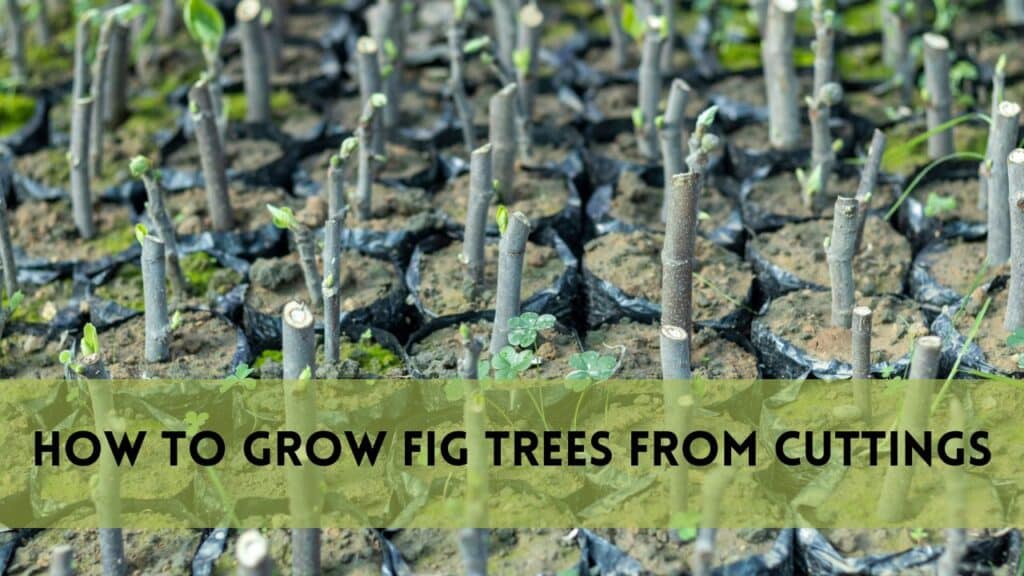Growing fig trees from cuttings can be a rewarding experience for any gardener or enthusiast. Fig trees, with their luscious fruit and vibrant foliage, add beauty and flavor to any garden or landscape. In this comprehensive guide, we will explore the steps and techniques involved to grow fig trees from cuttings. Whether you’re a seasoned gardener or a beginner, this guide will equip you with the knowledge and tools needed to grow healthy and thriving fig trees right in your own backyard.
Cuttings Fig Trees for Growth
It’s important to comprehend the fundamentals of fig trees and their propagation methods before beginning the process of cultivating fig trees from cuttings. Fig trees are members of the Ficus genus and are well-known for its unusual fruit, referred to as a syconium in botanical terminology.
Although these trees are native to the Mediterranean region, they are grown all over the world for their beautiful fruit and aesthetic appeal. When it comes to propagating fig trees, cuttings offer a simple and effective method.
Cuttings are sections of a parent plant that are removed and encouraged to develop roots and grow into new plants. Fig trees can be propagated from both hardwood and softwood cuttings, though softwood cuttings are often preferred for their higher success rate and faster growth.
Getting Ready for Cutting Fig Trees
The process of growing fig trees from cuttings begins with the selection of appropriate branches for propagation. Seek for pencil-thick diameter branches that are disease-free and in good condition. Select branches that are ideally from this season’s growth and show no evidence of sickness or damage.
How to Grow Fig Trees from Cuttings?
After you’ve determined which branches are appropriate, take 6 to 8-inch-long cuttings with clean, sharp pruners. Since the roots will form just below a leaf node, make each cut exactly below it. In order to prevent moisture loss and promote root growth, remove any leaves from the lowest portion of the cutting.
Planting the Cutting of Fig Tree
It’s time to root the cuttings and promote new development after they’ve been prepared. A potting mix that drains effectively or a mixture of perlite and peat moss should be added to a container. Make sure the growing medium is uniformly moist but not soggy by misting it but don’t let it soak.
Then, place the cuttings in the growing medium, making sure that each cutting is buried at least one-third of the way below the surface. To provide proper airflow and guard against fungal infections, make sure the cuttings are separated sufficiently. The cuttings may burn if the container is left in direct sunlight. Instead, place it in a warm, well-lit room.
Handling Fig Tree Slices after Cutting
For your fig cuttings to be successful throughout the rooting stage, proper care is essential. Maintain a constant moisture level in the growing medium, but don’t overwater it as this can cause rot. Regularly check the cuttings for symptoms of fungal problems or dehydration, and modify your watering regimen accordingly.
Sustaining humidity surrounding the cuttings might encourage root development in addition to adequate watering. This can be accomplished by placing a humidity dome or a clear plastic bag over the container to retain moisture and foster a rooting environment.
Establishing and Transplanting New Fig Trees
- The cuttings are ready to be moved into bigger containers or planted directly in the ground once they have robust roots, which usually happens after 6 to 8 weeks. For best development, select a spot that receives full sun exposure and enough drainage.
- Harden off the cuttings by exposing them to the outside gradually over a week before transplanting. This lessens transplant shock and aids in the plants’ adjustment to their new surroundings.
- Dig a hole that is marginally bigger than the root ball when planting the rooted cuttings, then backfill it with soil that has been combined with organic matter or compost. To help the soil settle and promote root development, give the recently transplanted fig trees plenty of water.
Tips for Upkeep and Care of Fig Tree Growth after Cutting
Your fig trees will remain healthy and productive as long as they receive the right upkeep and care after they are planted. For your fig trees to continue to thrive, remember these vital tips:
Reduction: Fig trees require regular pruning to keep them healthy and shaped. During the dormant season, prune fig trees to get rid of any crossing or overloaded growth, as well as any dead, diseased, or broken branches. Pruning lowers the danger of fungal infections, increases ventilation inside the canopy, and stimulates fruit development on younger branches.
Fertilisation: The proper nutrients must be given to fig trees in order for them to grow and produce fruit.
The ideal time to fertilise fruit trees is early in the spring, right before new growth begins, using a balanced fertiliser. Avoid overfertilizing as this could encourage excessive vegetative growth at the expense of fruit production. Look for signs of nutrient deficiencies in the fig plants and modify the fertilisation as needed.
Watering: Fig trees need moist soil on a regular basis, especially during the growing season. Water the soil thoroughly and sparingly enough to keep it evenly moist but not waterlogged. Mulching the ground around the bases of the fig trees regulates soil temperature, keeps weeds out of the way, and holds on to moisture.
To avoid stress and dehydration during dry spells or hot weather, water less frequently.
Protection from Frost: In regions where frost is a possibility, take preventative measures to protect fig trees from the cold. Winter is the best time to cover young or fragile fig trees with blankets or frost cloth when it freezes. Consider applying a protective layer or wrapping the trunk in insulation to prevent frost damage to its bark.
Control of Pests and illnesses: Aphids, scale insects, mites, and fungal infections are a few of the pests and illnesses that need to be routinely observed on fig trees. To reduce damage and preserve the health of your trees, use integrated pest control techniques, such as cultural practices, biological treatments, and targeted pesticide applications. You can stop the spread of diseases and pests by pruning off diseased or damaged plant portions.
Gathering and Preserving: Select ripe figs as soon as possible to prevent rotting and overripening.
When figs have a tiny bend at the neck and are tender to the touch, they are usually ready for harvesting. Avoid damaging the fruit or nearby branches as you gently twist the figs off the tree. Harvested figs should be kept cold and dry or refrigerated to prolong their freshness.
Annual Upkeep: Perform yearly upkeep on the fig trees, such as checking for damage, restocking the mulch around the trees’ bases, and pruning to control size and shape. In order to avoid long-term complications, evaluate the fig trees’ general health and vigour and swiftly resolve any problems or concerns.
FAQs
What is the duration required for fig cuttings to germinate?
Under ideal circumstances, fig cuttings usually take 6 to 8 weeks to form robust roots. On the other hand, rooting times might differ according to elements including humidity, temperature, and the condition of the cuttings.
Is it possible to cultivate fig trees from hardwood cuttings?
It is possible to produce fig trees from cuttings of both hardwood and softwood. Hardwood cuttings can be used with the right care and attention, but softwood cuttings tend to root more quickly and have a greater success rate.
When is the best time to water freshly rooted fig cuttings?
Watering regularly is necessary to maintain the growing medium damp but not soggy for freshly rooted fig cuttings. Depending on the location, water the cuttings every time the top inch of soil feels dry, which is usually every few days.
When is the ideal time to move fig cuttings that have rooted?
After the danger of frost has passed and the weather has warmed up, spring is the ideal time to transplant rooted fig cuttings. During the cooler months, transplanting can cause stress to young plants, which might impede their growth.
How do I protect fig trees from pests and diseases?
To protect fig trees from pests and diseases, monitor them regularly for signs of infestation or infection. Implement cultural practices such as proper pruning, adequate spacing, and good sanitation to minimize pest and disease pressure. Consider using organic or chemical controls as needed, following label instructions carefully.
Conclusion
Growing fig trees from cuttings is an easy and profitable way to multiply the number of plants you have. If you follow the guidelines in this book and give your fig trees the proper care and attention, you can enjoy the quantity and beauty of fig trees in your landscape or garden. Whatever your degree of gardening expertise, there is nothing like the satisfaction of grow fig trees from cuttings. I’m toasting to your productive gardening!





